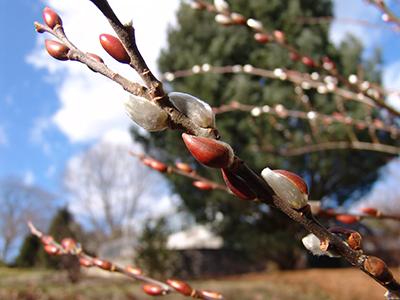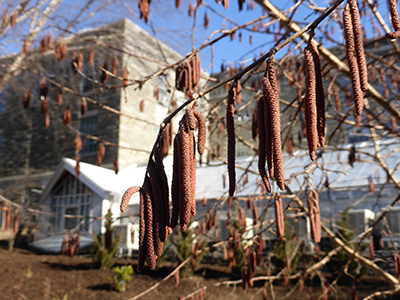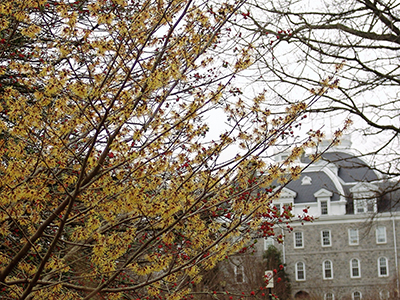
Plants of the Week: January 13, 2020
The wintertime is often thought to be a dull time of year in the garden. However, against the muted gray and brown tones of the winter landscape, unexpected plant features catch the spotlight, with previously unnoticed details becoming focal points. In fact, some plants are most notable for their winter interest, and are especially dazzling during these months.

One such plant which attracts attention in these months is Salix chaenomeloides, the giant pussy willow. While best known for the spring catkin display, S. chaenomeloides has large oblong leaves, which are wider than many of the Salix genus. The red buds and stems of this pussy willow are striking in its dormant season. The long wands of this willow are graced with large buds coated in a distinct glossy burgundy. As the bud sheath is pushed off, the red coloration contrasts with the white of the emerging catkins, providing additional interest.
This moisture-loving plant can be utilized as a small tree or large shrub; mature plants reaching a size of approximately 15’ tall and 8’ wide. This plant is best suited for use at the back of the garden bed, or in naturalized plantings. For gardeners with limited space, coppicing may be prudent. A vigorous grower, this willow responds well to coppicing and heavy pruning, and will produce more wands when treated this way. Native to China, Korea, and Japan, this willow is hardy to USDA zone 6. Plants will perform best in full sun; shaded locations are not recommended. You can find S. chaenomeloides below the Cut Flower Garden. photo credit: R. Robert

Another plant deserving acclaim in the winter is the stately Corylus fargesii, known colloquially as Farges’ filbert. The bark of this filbert is truly extraordinary, exfoliating in hues of white, light brown, dark brown and copper. While this tree is well established throughout arboreta, it is not well known outside the horticultural community or widely available through commercial distribution. This is ostensibly due to challenges in propagation and not for lack of admiration.
Preeminent woody plant connoisseur Michael Dirr likens the appearance of C. fargesii to the paperbark maple (Acer griseum), a tree widely revered for its ornamental bark. Numerous salmon colored catkins adorn the branches of C. fargesii, adding further winter interest. The leaves of this tree resemble those of birch trees (Betula spp.) and turn bright yellow in the fall.
Broad adaptability of Corylus fargesii has been reported, growing healthily in the Midwest, New England, mid-Atlantic states, and the South. Most well-drained soils should provide suitable growing conditions. Mature trees will reach approximately 40’ tall and 30’ wide and develop to have a tapered pyramidal form. Native to the mountains of Western China, this tree is quite cold tolerant, hardy to USDA zone 5. Fortunately, this tree is resistant to the Eastern Filbert Blight and Japanese beetles, both of which can ravage other Corylus species. You can find handsome specimens of this tree in the Winter Garden and in the circle outside of the Lang Music Building. photo credit: J. Coceano

Those who catch a glimpse of Hamamelis x intermedia ‘Luna’ in bloom would be hard pressed not to be smitten. This hybrid witchhazel stands out like a beacon in the winter, breaking up the monotony of the season with bright yellow flowers, reliably emerging in February and continuing through March into the springtime. This year we have been spoiled with a bloom period starting in early January.
H. x intermedia hybrids are admired for their superior winter flowering period, and take on intermediate characteristics of the parentage, Japanese and Chinese witchhazels (H. japonica and H. mollis, respectively). The flowers of Hamamelis shrubs are born in clusters over the entire plant when bare of leaves, and resemble citrus zest. Each flower has four crinkly petals, which droop in a spider-like form. The leaves of this witchhazel, like many in the genus, have wavy margins and turn golden in the fall. Flowers of the ‘Luna’ selection have a light citrus fragrance and are perhaps the lightest yellow of any witchhazel.
H. x intermedia ‘Luna’ is a medium to large sized shrub, with a loose, informal appearance, maturing to approximately 15’ tall and 15’ wide. H. x intermedia ‘Luna’ prefers a moist, well-drained soil and part shade but is adaptable to a wide range of conditions, tolerating both ample sun and shade as well as cold temperatures (USDA zone 5). Plants are also tolerant of clay soils, though intolerant of poorly drained soils and drought conditions.
Witchhazels are typically understory plants, making them well suited for woodland and streambank settings. However, plants in more sun will be fuller and produce more blooms. The ‘Luna’ selection may be best utilized as a specimen or in a shrub border for maximum prominence. Come see our H. x intermedia ‘Luna’ in the Scott Entrance Garden, and you’ll see why this garden stalwart is a favorite of ours for winter color. photo credit: R. Payne-Meyer





No Comments